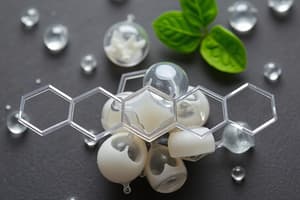Podcast
Questions and Answers
What is a lipid?
What is a lipid?
- Organic compound soluble in water
- Compound that contains carbohydrates
- Compound that only exists in animals
- Organic compound found in living organisms that is insoluble in water (correct)
What do lipids lack in terms of structural features?
What do lipids lack in terms of structural features?
Do not have a common structural feature
What are the classifications of lipids based on biochemical function?
What are the classifications of lipids based on biochemical function?
Biochemical function and saponification
What are energy-storage lipids?
What are energy-storage lipids?
Which of the following are considered membrane lipids?
Which of the following are considered membrane lipids?
What are emulsification lipids?
What are emulsification lipids?
What comprises messenger lipids?
What comprises messenger lipids?
What are protective coating lipids?
What are protective coating lipids?
What is the saponification reaction?
What is the saponification reaction?
What are saponifiable lipids?
What are saponifiable lipids?
Which of the following are examples of nonsaponifiable lipids?
Which of the following are examples of nonsaponifiable lipids?
What defines fatty acids?
What defines fatty acids?
What defines long chain fatty acids?
What defines long chain fatty acids?
What defines medium chain fatty acids?
What defines medium chain fatty acids?
What defines short chain fatty acids?
What defines short chain fatty acids?
What are the types of fatty acids?
What are the types of fatty acids?
What is a saturated fatty acid?
What is a saturated fatty acid?
What characterizes a monounsaturated fatty acid?
What characterizes a monounsaturated fatty acid?
What is a polyunsaturated fatty acid?
What is a polyunsaturated fatty acid?
What are the two types of unsaturated fatty acids?
What are the two types of unsaturated fatty acids?
What is the melting point of fatty acids affected by?
What is the melting point of fatty acids affected by?
What is the water solubility of short-chain fatty acids?
What is the water solubility of short-chain fatty acids?
What is the water solubility of long-chain fatty acids?
What is the water solubility of long-chain fatty acids?
Why are short-chain fatty acids only sparingly soluble?
Why are short-chain fatty acids only sparingly soluble?
Flashcards are hidden until you start studying
Study Notes
Lipids Overview
- Lipids are organic compounds in living organisms that are insoluble in water and soluble in non-polar organic solvents.
- They lack a common structural feature, creating a diverse group of molecules.
Classification of Lipids
- Classified based on biochemical function and saponification.
- Includes energy-storage lipids, membrane lipids, emulsification lipids, messenger lipids, and protective coating lipids.
Types of Lipids
- Energy-storage lipids: Primarily triacylglycerols, used for storing energy.
- Membrane lipids: Composed of phospholipids, glycolipids, and cholesterol, these form biological membranes.
- Emulsification lipids: Example includes bile acids, which aid in fat digestion.
- Messenger lipids: Include steroid hormones and eicosanoids, crucial for signaling.
- Protective coating lipids: Biological waxes that provide waterproofing and protection.
Saponification
- A chemical process involving hydrolysis in a basic solution.
- Results in saponifiable lipids, which can be broken down into smaller molecules during hydrolysis.
- Examples include triacylglycerols, phospholipids, sphingoglycolipids, cholesterol, and biological waxes.
- Nonsaponifiable lipids include steroid hormones, bile acids, and eicosanoids, which do not undergo this process.
Fatty Acids
- Naturally occurring monocarboxylic acids with linear carbon chains, typically having an even number of carbon atoms.
- Classified by chain length:
- Long-chain fatty acids (C12-C26)
- Medium-chain fatty acids (C8-C10)
- Short-chain fatty acids (C4-C6).
Types of Fatty Acids
- Two main types: saturated and unsaturated fatty acids.
- Saturated Fatty Acid (SFA): Fully hydrogenated with no double bonds; structural notation starts from the carboxyl end.
- Monounsaturated Fatty Acid (MUFA): Contains one cis carbon-carbon double bond.
- Polyunsaturated Fatty Acid (PUFA): Contains two or more double bonds, important for health.
Unsaturated Fatty Acids
- Numbering of double bonds starts from the opposite end of the carboxyl group.
- Structural notation indicates the total number of carbons and double bonds.
- Types include omega-3 and omega-6 fatty acids, which are essential for health.
Physical Properties of Fatty Acids
- Water solubility varies by chain length:
- Short-chain fatty acids are partially soluble due to the carboxylic group.
- Long-chain fatty acids are insoluble in water.
- Melting points are influenced by saturation:
- More unsaturated fatty acids have lower melting points and are typically liquid at room temperature.
Studying That Suits You
Use AI to generate personalized quizzes and flashcards to suit your learning preferences.





